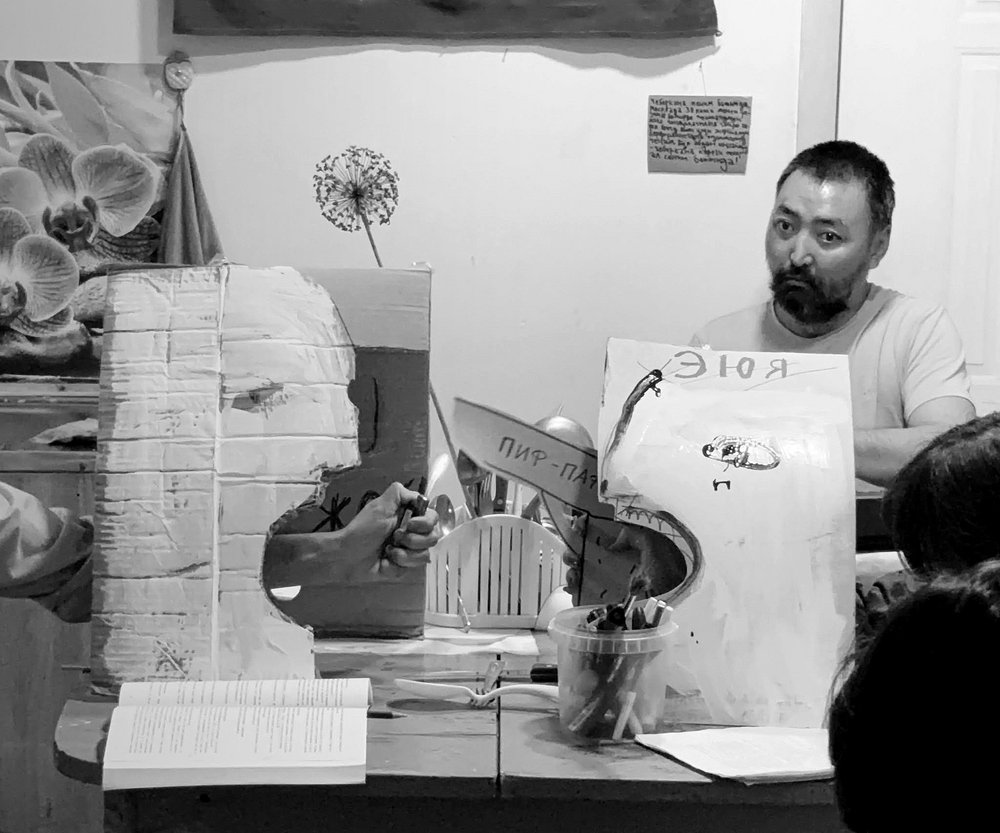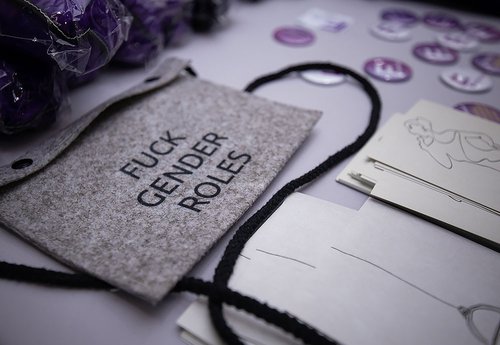Masked Identities: Aidarov’s Pop Critique of Kyrgyz Politics

Portrait of Chyngyz Aidarov at the Zamanbap Museum. Courtesy of the artist
Millennial multimedia artist Chyngyz Aidarov’s cartoon characters wearing traditional Kyrgyz caps and his darkly humorous solo and collective performances call out the complex realities of post-Soviet identity, migrant labor, and political disillusionment in contemporary Kyrgyzstan.
In a makeshift apartment home gallery in Bishkek, cartoon characters and paintings in the style of comic books are neatly hung around the walls. The familiar faces of Bender and Zoidberg, Spiderman and Skeletor from the hit American animation series ‘Futurama’ and ‘He-Man’ are wearing kalpaks and elechek - traditional Kyrgyz caps. Artist Chyngyz Aidarov (b. 1984) produced this work in the 2010s which was a particiarly intense period in Kyrgyzstani politics culminating in the ‘April Events’ – or the Kyrgyz Revolution. Following violent and bloody protests, Kurmanbek Bakiyev, the second president of Kyrgyzstan, was ousted for corruption and forced to leave the country. Aidarov refers to this period at the foothills of his own career as ‘Batal’on im. Chukova’ – battalion as a military unit combined with the name of his art school – as if he is a soldier of the art school. This seems apt for an artist whose works employ sharp humor and pop culture to critique nationalism and politics.
A painting of Spiderman in a kalpak and adidas tracksuit peeking out from behind a curtain hangs above the head of the artist’s bed, with red text, written in the Kyrgyz language, filling the background. The text reads like a blend of Soviet and Pop: ‘Spider Man, superhero, born in New York…he likes lagman, kumys, and Michael Jackson’. (Ed. lagman is a popular Uyghur dish of pulled noodles, meat, and vegetables, kumys is fermented horses’ milk.) The result is a curious hybrid, a merging of Kyrgyz, Russian, and pop cultures.
Elswhere, a work on paper ‘Ne Kerek?’ epitomizes the cultural hybrid figure. Translated as ‘Whatcha mean?’, both the phrase and the Adidas tracksuit depicted represent the vernacular language of gang culture. Tracksuits are often associated with gopniks, youths who skirt along the edges of the criminal world. This thuggish element is paired with traditional Kyrgyz ornamentation which is drawn on the face of the figure.
Further interest in gang or prison culture is visible in ‘Dyadya Fantomas’, or ‘Uncle Phantom’. The painting shows a green humanoid figure in suit and tie with a kalpak on his head. Red text painted in the background narrates something ‘Uncle Phantom’ once said to the artist. Aidarov went to Moscow in 2010 hoping to find work as an artist in the city. Without the necessary documents, he was arrested and put in prison. It was there that he met Uncle Phantom, who inspired this painting.
After this escapade, the artist finally went back to Moscow in 2017, taking on blue collar jobs, at that time one of over 800,000 Kyrgyz entry-level workers in Moscow, the second largest group of migrant workers in the city after the Uzbeks. Aidarov characterizes his time as a migrant worker in Moscow as both a performance and a financial necessity. He says that due to the high number of Kyrgyz migrant workers, driven by high unemployment and low wages in Kyrgyzstan, he had long been interested in migrant labor as a theme. His works from this period explore harsh living conditions and mistreatment of workers, but with a signature sense of humor. In one performance the artist stole cakes while working at a Moscow confectionery factory. A hand-written copy of a notice pinned up by the management now hangs in Aidarov’s hall. It reads:
Attention! Recently the following cakes have been stolen from the warehouse:
Medovik
Crimean Morning
Napoleon
Esterkhasi
Those caught with the cakes will be fired without pay.
The Administration
Other works examine the generational aspects of migrant and low-wage work. One piece, a caricature of two children, shows a boy and a girl wearing national headdresses, their wide, toothy exaggerated smiles as a contrast with the text on their shirts that reads, ‘in modern times’. In comic style speech bubbles the boy says, ‘I will be a taxi driver when I grow up’ and the girl adds, “and I will be a seamstress when I grow up.” In another comic book-style piece, a woman wearing an elechek, raises her hand to her son who cries: “Muuuum!!! When is dad coming back from Moscow??”. The mother replies angrily, “When we have cows, when we have livestock, then he’ll come!!! … that’s enough!” she threatens, “The Russians will come and take you away!!!”
Although grappling with sensitive subjects, the comic book aesthetic chips away at the seriousness of the situation, towing the line between the real and the not so real. You see this approach in Aidarov’s 2016 performance in the central Ala-Too square in Bishkek. Wearing a mask depicting Kyrgyzstan’s first president, Askar Akayev, the artist wandered around the square, going up to people apologizing and asking for their forgiveness. In 2005, Akayev fled the country following mass protests in what is now known as the Tulip Revolution. Rumors of his return swirled in 2016, prompting Aidarov to impersonate the president and perform the intimate gesture of begging for forgiveness from the people.
Aidarov’s work is about the notion of deception about complex identities, and the ongoing legacy of the Soviet Union that still shapes and defines Kyrgystan today. Many of Aidarov’s figures wear a kind of mask to both hide and reveal aspects of themselves, troubling the line between what is real and what is fiction. In his most recent project, the artist’s collective called ‘Zamanbap’, uses crudely made masks for art performances.
Like the cult superhero Spiderman’s mask, these conceal the identity of the performers while asserting new ones, producing new characters as an alternative reality. Just as in the sphere of pop culture and entertainment, personal identities are constructed, producing icons that operate in a liminal fictional reality. The multiplicity of experience comments on double standards or the hypocrisy of power and reflect how that impacts contemporary life.

















